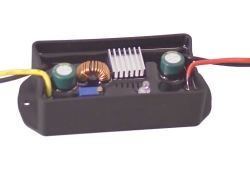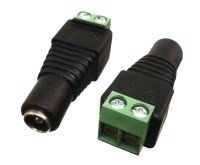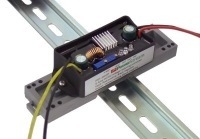How to get 24V from an ATX power supply
Use a DC converter to get that 24VDC
It just is not practical to extract 24 Volts directly from the ATX PSU. You can’t use two of the 12V lines in series because they have a common ground (and actually they are from a common source as well). You might try the -12 and +12 but there is very little power available, and you still have to be worried about the 24V device’s grounding, since that source of 24V has to be floating. But what you can do, and very easily, is to use a DC/DC converter. This little module is very useful for this purpose, and can get you up to 50 watts (or higher for short spurts). So even though you can’t get 24V from the ATX, you can “cheat” by including another DC converter, the PST-DCBP-24V. The best source of power in the computer is the +12V rail. The PST-DCBP will boost 5V or even 3.3V to +24V, but the efficiency is lower, so to control the heat you would have to limit the power to 10W to 20W. The +12V rail also contains most of the power in the larger ATX PSU form factory. And if you want a different voltage, you can adjust the trim-pot over a wide variety of voltages, such as 15V, 19V, or 21V. To tap power from the computer use one of the spare hard drive connectors, the yellow wire is +12V, and the black wire is, of course, ground.Optional barrel socket to screw terminal adapters
$2.50 each
Add to Cart
5.5 x 2.1 mm barrel plug

$2.50 each
Add to Cart
Optional DIN mounting hardware
(not including the rail)
$3.00
Add to Cart
Input operating voltage
2.9V to 23 VDC if you want 24VDC output, remember this
DC converter will only increase the input voltage
Output voltage
24VDC set at the factory, you can easily adjust it yourself,
up to 38V. Examples are 15V, 19V, 21V
Note: the output voltage must be higher than the input voltage
Note: the output voltage is adjustable by a trim pot from the top
of the package. We will adjust it to 24V before shipping unless
you request aspecific voltage when ordering.
Output Power
Boosting 12V to 24V you can run up to 50 watts
continuously, or even higher for brief excursions
Maximum output current
Up to 2.1 amps continuous with 12V input and 24V output
Under voltage lockout
2.6V ± 0.1V
Temperature Range
-35C to +60C
Electrostatic immunity
Human body model ±2000V
Operating temperature range
-20 °C to +75 °C (-4 °F to 167 °F)
Over current protected
Pulse by pulse over current protected
Over current protection
Yes, by reverse biased diode across the input terminals. A
fuse in the input line is required to prevent damage.
Thermal protected
Automatic restart with 15 °C hysteresis
Size
104x52x13mm (4x2x0.5 inches) including flange
Weight
2.4 oz, 68g
Maximum output current can be determined with the following formula
Imax = [Vin/(Vout+0.5)] * 4.2Amps
Where Vin is the minimum expected input voltage in the application. In other words, if the power source is a battery don’t use the average voltage, but the minimum voltage of the battery during normal discharge.
Here is a chart of typical values:
Vin
Vout
Imax
Watts
3
24
0.5A
12W
5
19
1.1A
21W
5
24
0.83A
20W
12
19
2.6A
49W*
12
24
2.1A
50W*
12
36
1.4A
50W*
24
28
3.5A
98W*
24
36
2.8A
100W*
36
38
3.9A
148W*
Potential Uses
- 24V in a PC for powering PLC controllers
- 24V in a PC for powering stepper motor controllers
- 24V in a PC for powering linear actuators




